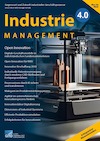Search


Bibtex
Cite as text
@Article{Jacob+Grosse+Morana+König,
Cite-key = "Jacob2023",
Year= "2023",
Number= "1",
Volume= "IM 39",
Pages= "23-26",
Journal = "Industrie 4.0 Management",
Title= "Mein Kollege ist ein Roboter – Akzeptanz der kollaborativen Robotik in Lagerhäusern",
Author= "Frederic Jacob, Eric Grosse, Stefan Morana und Cornelius J. König, Universität des Saarlandes",
Doi= "https://doi.org/10.30844/IM_23-1_23-26",
Abstract= "Die Lagerhaltung ist in vielen Unternehmen sehr arbeits- und kostenintensiv. Die Digitalisierung und Automatisierung von manuellen Lagerprozessen können die Effizienz steigern, Kosten senken und Mitarbeitende entlasten. Dabei finden kollaborative Roboter, die sich Arbeitsaufgaben mit Mitarbeitenden teilen, zunehmend Anwendung in Lagerhäusern. Der unreflektierte Einsatz solcher Roboter kann jedoch die Akzeptanz der Mensch-Roboter-Kollaboration negativ beeinflussen. Verschiedene Einflüsse wie Angst vor Arbeitsplatzverlust, höherer kognitiver Stress, erwarteter Mehraufwand oder die Sorge vor Verletzungen können die Zusammenarbeit zwischen Mensch und Roboter behindern und sich negativ auf den wirtschaftlichen Nutzen auswirken. Dieser Beitrag stellt mögliche Barrieren für die Akzeptanz der kollaborativen Robotik in Lagerhäusern vor und diskutiert Handlungsempfehlungen für eine menschzentrierte, nachhaltige Mensch-Roboter-Kollaboration.",
Keywords= "Lagermanagement, Kollaborative Roboter, Menschliche Faktoren, Technologie-Akzeptanz",
}
Frederic Jacob, Eric Grosse, Stefan Morana und Cornelius J. König, Universität des Saarlandes(2023): Mein Kollege ist ein Roboter – Akzeptanz der kollaborativen Robotik in Lagerhäusern. IM 391(2023), S. 23-26. Online: https://doi.org/10.30844/IM_23-1_23-26 (Abgerufen 22.10.24)
Open Access
Abstract
Abstract
Die Lagerhaltung ist in vielen Unternehmen sehr arbeits- und kostenintensiv. Die Digitalisierung und Automatisierung von manuellen Lagerprozessen können die Effizienz steigern, Kosten senken und Mitarbeitende entlasten. Dabei finden kollaborative Roboter, die sich Arbeitsaufgaben mit Mitarbeitenden teilen, zunehmend Anwendung in Lagerhäusern. Der unreflektierte Einsatz solcher Roboter kann jedoch die Akzeptanz der Mensch-Roboter-Kollaboration negativ beeinflussen. Verschiedene Einflüsse wie Angst vor Arbeitsplatzverlust, höherer kognitiver Stress, erwarteter Mehraufwand oder die Sorge vor Verletzungen können die Zusammenarbeit zwischen Mensch und Roboter behindern und sich negativ auf den wirtschaftlichen Nutzen auswirken. Dieser Beitrag stellt mögliche Barrieren für die Akzeptanz der kollaborativen Robotik in Lagerhäusern vor und diskutiert Handlungsempfehlungen für eine menschzentrierte, nachhaltige Mensch-Roboter-Kollaboration.
Keywords
Schlüsselwörter
Lagermanagement, Kollaborative Roboter, Menschliche Faktoren, Technologie-Akzeptanz
References
Referenzen
- Winkelhaus, S.; Grosse, E. H. (2020) Logistics 4.0: a systematic review towards a new logistics system. In: International Journal of Production Research 58 (2020) 1, S. 18-43.
- Maderna, R.; Poggiali, M. u. a.: An online scheduling algorithm for human-robot collaborative kitting. In: IEEE International Conference on Robotics and Automation (ICRA). 2020.
- Winkelhaus, S.; Grosse, E. H. u. a.: Towards a conceptualization of Order Picking 4.0. In: Computers & Industrial Engineering 159 (2021), 107511.
- Firescu, V.; Gaşpar, M.-L. u. a.: Collaboration Between Humans and Robots in Organizations: A Macroergonomic, Emotional, and Spiritual Approach [Brief Research Report]. In: Frontiers in Psychology 13 (2020), 855768.
- Scherf, J.: Was ist Logistik 4.0? Alles zum Thema Digitalisierung & Logistik. URL: www.mm-logistik.vogel.de/was-ist-logistik-40-alles-zum-thema-digitalisierung-logistik-a-692722, Abrufdatum 02.04.2022.
- Hentout, A.; Aouache, M. u. a.: Human–robot interaction in industrial collaborative robotics: a literature review of the decade 2008–2017. In: Advanced Robotics 33 (2019) 15-16, S. 764-799.
- Aaltonen, I.; Salmi, T. u. a.: Refining levels of collaboration to support the design and evaluation of human-robot interaction in the manufacturing industry. In: Procedia CIRP 72 (2018), S. 93-98.
- Berx, N.; Decré, W. u. a.: Identification and classification of risk factors for human-robot collaboration from a system-wide perspective. In: Computers & Industrial Engineering 163 (2022), 107827.
- Andronas, D.; Apostolopoulos, G. u. a.: Multi-modal interfaces for natural Human-Robot Interaction. In: Procedia Manufacturing 54 (2021), S. 197-202.
- Donohue, K. L.; Özer, Ö. u. a.: Behavioral Operations: Past, Present, and Future. In: SSRN Electronic Journal (2019).
- Pasparakis, A.; de Vries, J. u. a.: In Control or under Control? Human-Robot Collaboration in Warehouse Order Picking. In: SSRN Electronic Journal (2021).
- Neumann, W. P.; Winkelhaus, S. u. a.: Industry 4.0 and the human factor – A systems framework and analysis methodology for successful development. In: International Journal of Production Economics 233 (2021), 107992.
- Spurk, A.; Grosse, E. u. a.: Drohnen in der Intralogistik: Chancen und Barrieren. In: Zeitschrift für wirtschaftlichen Fabrikbetrieb 117 (2022) 7-8, S. 503-507.
- Lambrechts, W.; Klaver, J. S. u. a.: Human Factors Influencing the Implementation of Cobots in High Volume Distribution Centres. In: Logistics 5 (2021) 2.
- Hendrick, H. W.: Human Factors in Organizational Design and Management. In: Hancock, P. A. (Hrsg.): Advances in Psychology 47. North-Holland 1987.
- Alaiad, A.; Zhou, L.: The determinants of home healthcare robots adoption: An empirical investigation. In: International Journal of Medical Informatics 83 (2014) 11, S. 825-840.
- Venkatesh, V.; Morris, M. G. u. a.: User Acceptance of Information Technology: Toward a Unified View. In: MIS Quarterly 27 (2003) 3, S. 425-478.
- Baumgartner, M.; Kopp, T. u. a.:. Analysing Factory Workers’ Acceptance of Collaborative Robots: A Web-Based Tool for Company Representatives. In: Electronics 11 (2022) 1, 145.
- Fukushima, Y.; Asai, Y. u. a.: DigiMobot: Digital Twin for Human-Robot Collaboration in Indoor Environments. IEEE Intelligent Vehicles Symposium (IV). 2021.
- Chadalavada, R. T.; Andreasson, H. u. a.: Bi-directional navigation intent communication using spatial augmented reality and eye-tracking glasses for improved safety in human–robot interaction. In: Robotics and Computer-Integrated Manufacturing 61 (2020), 101830.
- Hata, A.; Inam, R. u. a.: AI-based Safety Analysis for Collaborative Mobile Robots. In: 24th IEEE International Conference on Emerging Technologies and Factory Automation (ETFA). 2019.
- Ivsic, B.; Sipus, Z. u. a.: Analysis of Safe Ultrawideband Human-Robot Communication in Automated Collaborative Warehouse. In: 14th European Conference on Antennas and Propagation (EuCAP). 2020.
- Vitolo, F.; Rega, A. u. a.: Mobile Robots and Cobots Integration: A Preliminary Design of a Mechatronic Interface by Using MBSE Approach. In: Applied Sciences 12 (2022) 1, 419.
- Khalid, A.; Kirisci, P u. a.: Security framework for industrial collaborative robotic cyber-physical systems. In: Computers in Industry 97 (2018), S. 132-145.
- Lorson, F.; Fügener, A. u. a.: New team mates in the warehouse: Human interactions with automated and robotized systems. In: IISE Transactions (2022), S. 1-18.
- Niu, Y.; Schulte, F. u. a.: Human Aspects in Collaborative Order Picking – Letting Robotic Agents Learn About Human Discomfort. In: Procedia Computer Science 180 (2021), S. 877-886.
- Jost, J.; Kirks, T. u. a.: Safe Human-Robot-Interaction in Highly Flexible Warehouses using Augmented Reality and Heterogenous Fleet Management System. In: IEEE International Conference on Intelligence and Safety for Robotics (ISR). 2018.
- Petković, T.; Puljiz, D. u. a.: Human intention estimation based on hidden Markov model motion validation for safe flexible robotized warehouses. In: Robotics and Computer-Integrated Manufacturing 57 (2019), S. 182-196.
- Szafir, D.; Mutlu, B. u. a.: Designing planning and control interfaces to support user collaboration with flying robots. In: The International Journal of Robotics Research 36 (2017) 5-7, S. 514-542.
- Fruggiero, F.; Lambiase, A. u. a.: Cognitive Human Modeling in Collaborative Robotics. In: Procedia Manufacturing, 51 (2021), S. 584-591.
- Breque, M.; De Nul, L u. a.: Industry 5.0 : towards a sustainable, human-centric and resilient European industry. Publications Office. 2021.

 English
English
